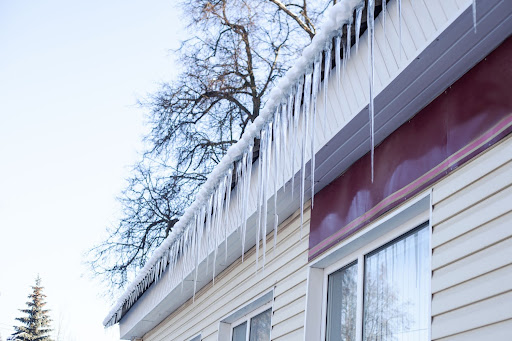Winter can be beautiful, but it can also bring significant challenges for homeowners. This is especially true when it comes to managing snow and ice in gutters.
One of the most effective ways to prevent dangerous ice dams and icicles is by installing gutter heating systems, also known as heat trace or de-icing cables. These systems are designed to keep gutters, downspouts, and roofs clear of ice buildup, helping protect your home from costly water damage while ensuring your safety.
In this blog, we’ll explore how heated gutters work, as well as how to install them effectively for a worry-free winter!
How Do Heated Gutters Operate?
Heated gutters use a simple yet effective mechanism designed to combat the challenges posed by winter weather. At the heart of these systems are electrically heated cables, strategically installed along the edge of your roof, within your gutters, and extending down your downspouts. When activated, these cables generate heat that melts snow and ice, effectively preventing the formation of ice dams.
Unfortunately, ice dams are a common winter problem; they occur when the warmth from your attic causes snow on the roof to melt. This meltwater then flows down to the colder eaves, where it refreezes, forming a dam. As more snow melts, the water backs up behind the dam, potentially seeping under roof shingles or spilling over the sides of gutters. The result? Your home is at a serious risk for water damage!
Heating gutters interrupt this cycle by maintaining a clear drainage path. By continuously melting snow and ice, these systems keep water flowing freely through the gutters and downspouts.
This method not only protects your roof and gutters but also helps prevent costly repairs during the harsher winter months.
Benefits of Heat Trace Cables and De-Icing Cables
Installing a heat trace or de-icing cable offers numerous advantages, particularly in regions like South Jersey, where winter brings heavy snow and ice each year.
Prevent Ice Dams
The foremost advantage of heated gutters is their ability to prevent ice dams. These dams can lead to significant water damage, affecting your roof, walls, insulation, and even the foundation of your home. By ensuring that your gutters remain clear, these systems help avert the risk of water backing up and causing damage.
Avoid Costly Repairs
Ice dams and icicles can be incredibly destructive. When water backs up due to clogged or frozen gutters, it may seep into your home, damaging ceilings, walls, or insulation. Investing in a gutter de-icing cable is a proactive measure that can save you thousands of dollars in potential repair costs, making it a wise financial decision for South Jersey homeowners.
Safety
Icicles hanging from gutters are not just unsightly; they also pose a serious safety risk! Large icicles can fall unexpectedly, potentially causing injury to people and damage to vehicles or landscaping. Heated gutters help prevent the formation of these hazards for a much safer environment around your home.
Protect Gutters and Roofing
Heavy ice buildup also places significant strain on gutters and roofing materials, potentially leading to structural damage. By keeping your gutters free of ice, you reduce the stress on your home’s exterior.
Types of Heated Gutter Systems
There are several types of heat trace and de-icing cables available, each offering varying levels of efficiency and ease of installation.
Constant-Wattage Cables
Constant-wattage cables are a straightforward solution for gutter heating. These cables deliver a fixed amount of heat along their entire length, regardless of the outside temperature. This consistent heat output means that ice and snow are effectively melted, keeping gutters and downspouts clear.
However, because they do not adjust to changing weather conditions, they can be less energy-efficient compared to other options. They might consume more electricity, potentially leading to higher energy bills. Despite this, their reliability and simplicity make them a popular choice for many homeowners.
Self-Regulating Cables
For those seeking energy-efficient heated gutters, a self-regulating heat trace cable is an excellent choice! These cables automatically adjust their heat output based on the surrounding temperature. When the temperature drops, the cable increases its heat production, and as it warms up, the output decreases.
This dynamic adjustment not only makes self-regulating cables more energy-efficient but also enhances safety by preventing overheating.
Electric Radiant Heating Systems
For comprehensive protection against snow buildup and ice dams, some homeowners opt for full electric roof heating systems. These systems use radiant heat (the transfer of heat energy through electromagnetic waves) to warm large sections of the roof, effectively preventing snow accumulation and ice formation.
While electric radiant heating systems are more complex and expensive to install, they offer broader protection compared to cable systems. This makes them ideal for homes in regions with heavy snowfall or for those looking to protect larger roof areas.
Though the initial investment can be higher, the peace of mind and extensive coverage they provide are often well worth the cost.
Installation Tips for Heated Gutters
Installing a gutter heat trace cable is a great DIY project to protect your home. Follow these essential tips for a successful installation!
Plan the Layout
Before you begin, take the time to assess your roof and gutters. Identify areas where ice tends to accumulate, such as the eaves, valleys, and around skylights.
These are critical spots where snow is likely to melt and refreeze, making them prime locations for cable installation. Remember that a well-thought-out layout will maximize the effectiveness of your heating system!
Secure the Cables Properly
Proper installation of the cables is very important for even heat distribution. Try to install the heat cables in a zigzag pattern along the edge of the roof and inside the gutters; this pattern will make certain that snow and ice melt effectively across the entire surface.
You’ll also want to use manufacturer-recommended clips and fasteners to secure the cables, as these are designed to hold them in place without damaging your roof or gutters.
Use a Dedicated Circuit
To prevent electrical overloads, plug your heat trace cables into a dedicated electrical circuit. This way, the heated gutters have enough power to operate efficiently without tripping your home’s electrical system.
Install a GFCI Outlet
Since these systems are used outdoors, it’s a good idea to plug them into a ground-fault circuit interrupter (GFCI) outlet. A GFCI outlet protects against electrical hazards in wet conditions, reducing the risk of shock or fire.
Maintenance and Care of Gutter Heating Systems

Once installed, gutter heating systems require minimal maintenance. However, periodic checks are essential to ensure they function effectively throughout the winter months!
Inspect for Wear and Tear
Before the onset of heavy snowfall, take the time to inspect your heat trace cables for any signs of wear and tear. Look for damage such as fraying, exposed wiring, or any other visible issues.
If you spot any problems, you’ll need to replace the damaged sections ASAP for proper protection.
Have Your Gutters Cleaned Regularly
Even with a heating system in place, debris can still accumulate and cause gutter clogs. As such, it’s important to have your gutters cleaned out by professionals thoroughly before the next winter storm sets in.
What’s more, debris often obstructs water flow, reducing the effectiveness of your heat cables. By maintaining clean gutters, you allow the heating system to work optimally, preventing ice dams while ensuring proper drainage.
Monitor Snow Accumulation
While heated gutters are designed to melt snow and ice, they may not be able to handle extremely large snowfalls on their own. In such cases, manual snow removal may still be necessary.
Using a roof rake will help reduce the weight of snow on your roof, alleviating the load on your heat trace system. In addition to protecting your roofing, this also enhances the performance of your heating cables.
Warm Up this Season with Van’s Rain Gutters!
Gutter heating systems protect your home from water damage and improve overall safety around your property. With proper installation, they will provide years of reliable performance and peace of mind throughout the entire winter season!
Need to make sure your gutters are prepared for a new heating system and the weather ahead? Our expert team is here to provide comprehensive gutter inspections and cleaning services. Contact Van’s today for a free quote!

